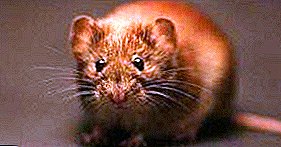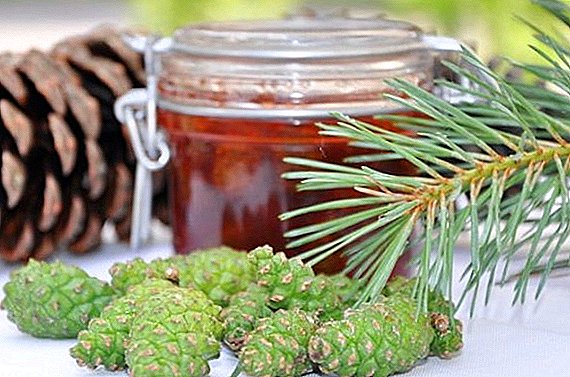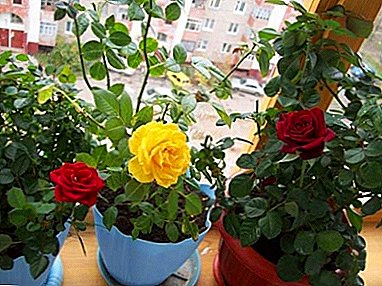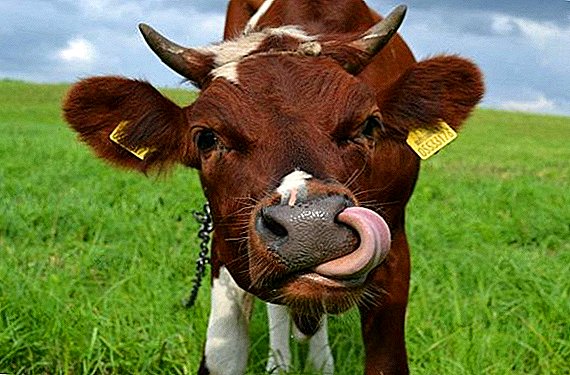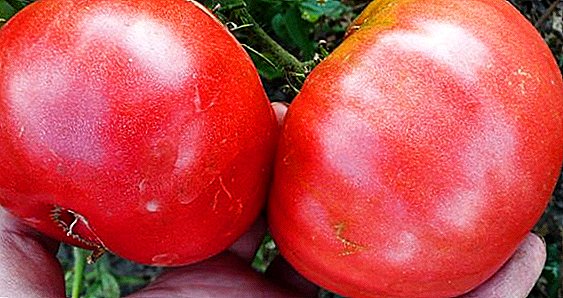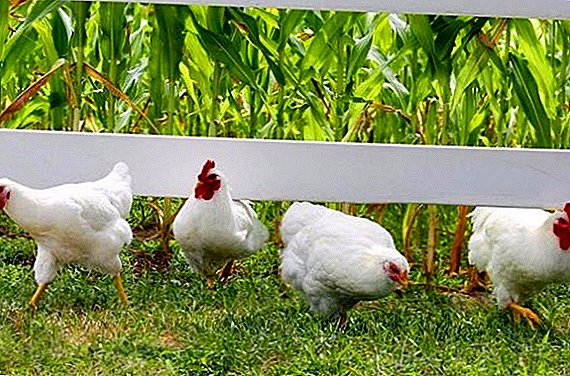 The chicken, perhaps, can be attributed to the most popular poultry in Europe. It is grown for various purposes, in particular, there are hens of the egg and meat directions, as well as decorative breeds. Depending on the purpose, the birds differ significantly from each other in many criteria, both external and internal.
The chicken, perhaps, can be attributed to the most popular poultry in Europe. It is grown for various purposes, in particular, there are hens of the egg and meat directions, as well as decorative breeds. Depending on the purpose, the birds differ significantly from each other in many criteria, both external and internal.
It is not known for certain when the purposeful selection of chickens for meat began, however many breeds have been bred for more than one hundred years.
Did you know? Meat chicken from the egg can be distinguished even at first glance. They are larger in size and weight, stocky, have softer feathers and thick strong legs. Compared to other breeds, meat chickens are calmer in temperament, are not afraid of people, easily tolerate stress and unexpected changes in housing conditions.
Brama
Brama is one of the most famous hens of meat breed, bred several centuries ago as a hybrid of Malay chicken with Cochinquin. Asia is considered the birthplace of the bird, from where in the second half of the nineteenth century the hen came to Great Britain and the United States, and from there it became widespread almost all over the world.
The breed of chicken Brahma is distinguished by the following external features:
- strong round wings, elongated legs and a large body with lots of meat;
- quite tall and proud posture;
- small scallop, but fleshy, teeth almost invisible;
- lush fan-shaped tail;
- the beak is bright yellow, powerful enough;
- ears of oblong shape, small;
- plumage is very thick, even on the feet.
The color of the Brahma chickens is varied.
So, these birds have gray feathers with a silvery tip, making up a complex semi-oval pattern, black plumage on the neck with a white rim. Roosters have head and chest in silver-gray shades, and the lower part is green-black.  There are white-silver Brahma with black tail, wings and neck, birds with very beautiful beige plumage, as well as light straw color with a black-gray feather tip (the roosters in such a color of the head and back are fiery-red, the lower part is emerald black).
There are white-silver Brahma with black tail, wings and neck, birds with very beautiful beige plumage, as well as light straw color with a black-gray feather tip (the roosters in such a color of the head and back are fiery-red, the lower part is emerald black).
Chicken Brama has a weight of not more than 3.5 kg, a rooster can reach 4.5 kg. Poultry is harsh, but differs in increased dietary characteristics and nutritional value.
Although chicken Brama belongs to meat breeds, it is also grown for decorative purposes, as well as to participate in sports.
The breed is not very demanding, however, given its considerable size, it requires abundant, varied and high-calorie nutrition with a high content of fats, proteins and vitamins. In addition to grain and animal feed, poultry must include fresh apples, cucumbers, zucchini or other vegetables and fruits.
Broiler
Broiler is not a breed, but a technology of breeding poultry. This term is called young (weighing no more than 2 kg), which is very quickly grown specifically for use in food. The etymology of the word (English broiler, from broil - “fry on fire”) speaks for itself: the best young chicken is the best and fastest on an open fire. The meat of such poultry has higher dietary and taste qualities and is therefore more useful, especially for sick or elderly people, as well as in baby food.  Various broiler chicken breeds are used as broilers, for example, Cornish white, Plymouth, Rhode Island, etc. They are quite unpretentious and grow very quickly (the bird required for slaughter weight can reach in just two months, while a chicken of a normal breed at that age weighs four times less - only 0.5 kg).
Various broiler chicken breeds are used as broilers, for example, Cornish white, Plymouth, Rhode Island, etc. They are quite unpretentious and grow very quickly (the bird required for slaughter weight can reach in just two months, while a chicken of a normal breed at that age weighs four times less - only 0.5 kg).
During the season (from spring to autumn) at home from one layer you can grow up to seven dozen broilers (3-4 generations). Chickens can be grown in a closed dry and bright room with a walking area outdoors, which chickens need for normal growth.
Sawdust, straw chop, corn kernels or sunflower husk are used as bedding. Periodically litter should be changed, removing the top layer.
The quality of broiler chicken meat depends on the quality of food. In addition to the feed or self-prepared mixture, the food should be enriched with protein (for this you can use fish or meat and bone meal, cottage cheese, milk), vegetables and greens. Also, baker's yeast is added to the feed (1-2 g per chicken), and to saturate the body with calcium - egg shells or chalk.
Jersey Giant
The Jersey Giant is the largest meat breed of chickens, bred at the beginning of the last century in the United States as a result of crossing the dark Brahma, Orpington, Langshan, and some others. The bird is black, white and very elegant blue.
The birds are of enormous size, and therefore can be kept in cages with a fairly low fence (the bird cannot overcome high barriers). Despite the fact that the Jersey giant likes space, it can be successfully grown in small spaces.  The body of this chicken, like other representatives of the meat breed, is massive and horizontal, the legs are medium and very strong. Roosters have a short tail, scallop leafy.
The body of this chicken, like other representatives of the meat breed, is massive and horizontal, the legs are medium and very strong. Roosters have a short tail, scallop leafy.
Excellent breed for growing at home, and, in addition to meat qualities, these chickens are also well carried, so they can be used as egg.
Important! Layers of the Jersey giant, due to their size, are capable of crushing newly laid eggs under their own weight. Also, these birds, because of their slowness, often throw eggs out of the nest. This feature should be taken into account if the bird is grown for eggs: an artificial incubator can be salvation, as well as the lining of eggs to layers of smaller breeds.
The young of this chicken grows much faster than other breeds, which dictates some features of feeding the chicks: they need to get protein, vitamins and calcium in excess for the correct weight gain.
Dorking
It is considered perhaps the most meat breed of chickens, distinguished by the best productivity in meat production. Bred in England at the end of the XIX century.
Chickens of Dorking breed are rather large, have a long wide body that looks like a quadrilateral, a large head that almost immediately passes into the body. Wings fit snugly to sides, beak curved downwards, fan-like tail. Roosters' scallops are standing upright, and females are hung to the side - this feature allows you to accurately determine the sex of the bird.  Dorking plumage is presented in the form of a variety of colors: from smooth-white, gray and black to blue, iridescent motley and striped-red.
Dorking plumage is presented in the form of a variety of colors: from smooth-white, gray and black to blue, iridescent motley and striped-red.
Important! When breeding this breed, the main condition is control over weight gain, because the right balance between vitamins and trace elements in the composition of the feed determines both the general condition and weight of the bird, and the quality of its meat.
The ratio of chickens and roosters in the flock should be 10: 1.
Dorking rather whimsical to temperature conditions, in particular, poorly tolerate a sharp change of heat and cold, as well as dampness. Birds are prone to encephalitis, so a few weeks before laying it is imperative to vaccinate them.
In general, despite the excellent meat qualities, this breed should not be chosen by novice and inexperienced poultry farmers, since the bird requires a lot of attention and careful care.
Cochinquin
A very ancient, but now rather rare breed, is grown more for ornamental purposes, however the meat of this bird is also highly valued. The homeland of this bird is China, in the nineteenth century the chicken was brought to Europe, where it was widely used by breeders.
Cochinquins are presented in two varieties - ordinary and dwarf. The differences are only in size.  Kokinhin looks like Brama because he is one of her ancestors. They have a majestic appearance thanks to a bright red upright ridge, similar to the royal crown, and also to shaggy feathering of a red, yellow, blue or partridge color (the feathers of the Cochinmen, along with meat, have a wide economic use). By temperament, the birds are quite sluggish. Not knowing how to fly, they prefer to sit quietly on the lower perches and not to show excessive activity.
Kokinhin looks like Brama because he is one of her ancestors. They have a majestic appearance thanks to a bright red upright ridge, similar to the royal crown, and also to shaggy feathering of a red, yellow, blue or partridge color (the feathers of the Cochinmen, along with meat, have a wide economic use). By temperament, the birds are quite sluggish. Not knowing how to fly, they prefer to sit quietly on the lower perches and not to show excessive activity.
The weight of the chicken can reach 4.5 kg, the cocks are about 1 kg larger. In the year the hen produces up to one hundred eggs. Cochinquins are unpretentious, but need a varied and balanced diet with the obligatory addition of whole grasses (feed needs more young and layers). The advantages of the breed include high cold resistance.
Cornish
Breed, bred in England in the middle of the last century, in a period when the country was in dire need of meat. It was derived exactly as a meat chicken, the features of which should have been a large weight with minimal feeding.
As a rule, the plumage of these chickens is white, sometimes it is found with black patches. Feathers a little, missing on their paws. The body is large, wide, long neck, tail and beak short. In terms of growth, these birds are somewhat smaller than their other cousins of meat breeds. 
Did you know? Cornish is a breed marked by the American standard of excellence among this type of poultry.
The removal of Cornish was associated with numerous problems due to the difficulty of the task: the bird was badly born, the eggs were too small, and the chickens were painful. However, over time, the breed has been improved so much that today it is already used as a basis in breeding research.
Cornish chickens are unpretentious and hardy, grow quickly and feel great in conditions of limited space. Feed the chickens consume significantly less than the representatives of other breeds. It is necessary to add corn to the feed, as well as sand to improve digestion.
A hen lasts up to three years and can carry up to 170 eggs a year. The disadvantage of the breed is not very high hatchability of chickens - no more than 70%.
Malin
Bred in Belgium in the nineteenth century. In different languages it is called differently: Mechelen, Meklin, Mecheln, as well as Kuku or Koko (this is because the breed is named after the ancient city where it was bred, and its name has come down to us in different versions).
Malin chickens have a weight of about 4 kg, roosters - up to 5 kg. Eggs are almost all year round, up to 160 pieces. The breed is valued as meat and eggs - they are very tasty, nutritious and large. 
Did you know? A club of connoisseurs of chickens Malin has been operating in Belgium for several decades. Members of the club are engaged in selection, hold various exhibitions and in every possible way advertise their favorite breed.
Malin is a very cumbersome, heavy and tightly knit chicken. The constitution is horizontal, the wings are small, adjacent to the body, eyes are round. Scallop bright red, small size. Roosters also have a red beard and earlobes. The paws are strong, strongly feathered, unlike the tail. Most often, striped plumage, there are also white, black, blue, pearl and other raspberry color. The bird has a particularly juicy and tender meat.
Among the disadvantages of the breed can be noted bad maternal instinct, some voracity and fastidiousness to food. However, the poultry is not demanding for other housing conditions, and the chickens survive quite well.
Malin chickens may be kept in cages, but need space. Birds do not know how to fly, so a high hedge is not required.
Due to the dense plumage, the chicken is cold-resistant.
Plymouth Rock
The breed was bred in the middle of the nineteenth century by US breeders. The name consists of two parts: Plymouth - the name of the city, which is the birthplace of the chicken, and "rock" (English Rock), which means rock - as a symbol of large size, strength and endurance of the breed. Chickens are also characterized by a large amount of meat of the highest quality, as well as the ability to gain weight quickly.
Plymouth Strokes come in different shades, but white chickens are the most enduring and therefore are most often hatch. These are the largest chickens in size.
The chickens are broad in the chest, have a not very large head, a well-feathered neck and tail, a yellow short beak and red eyes.  Plymouthrocks are grown for both meat and eggs, but the meat is considered the main direction. The meat of these chickens is tender, similar in taste to broiler. The disadvantage is not too appetizing yellowish shade of pulp.
Plymouthrocks are grown for both meat and eggs, but the meat is considered the main direction. The meat of these chickens is tender, similar in taste to broiler. The disadvantage is not too appetizing yellowish shade of pulp.
Breed unpretentious to climate fluctuations, calm, has good immunity. Growth of young stock occurs rather quickly - at the age of six months the females begin to nest, which is a record among chickens.
Chickens are fed the same feed as the parents, but the food should be crushed and add corn flour, cottage cheese, boiled eggs and chopped greens.
Sick or non-standard chicks are culled.
Orpington
A very popular English breed, due to its high productivity and ability to quickly build up the meat mass. Orpington is a chicken with an unusually lush soft plumage and a massive, almost square body. The head is small, the comb and earlobes are bright red, the tail is short. Compared to other chickens, Orpingtons are considered undersized. There are many colors, but the legs of the chicken are either black or white-pink.
Orpington meat has high dietary characteristics due to its low fat content.
By its nature, it is practically a manual chicken, and therefore, given the very aesthetic appearance, it is often raised as a pet.  Representatives of this breed are excellent hens and good mothers, which ensures excellent chick survival. The weight of young animals is gaining quickly enough, and females have almost the same mass as the males.
Representatives of this breed are excellent hens and good mothers, which ensures excellent chick survival. The weight of young animals is gaining quickly enough, and females have almost the same mass as the males.
Among the drawbacks of the breed are unlimited appetite and a tendency to obesity, slow growth of young animals and a small number of eggs.
Feed these chickens should be combined, the number of meals per day - two. In addition to the main feeding trough, the females of these chickens should always have direct access to chalk or shells, which is necessary for replenishing calcium reserves.
Fireball
The fireball is a breed of chickens that was bred by industrial breeding in France, which is why it is sometimes called French meat.
With the elegance characteristic of the French, the breeders managed to combine useful properties with an aesthetic appearance.
The body of the chicken is massive, slightly oblong, the paws are low, covered with feathers, the tail is small but fluffy. Under the short beak there is a large beard, the lobes are hidden under the bright sideburns, the short neck is heavily feathered.
Due to the number of plumage, the breed is considered to be cold-resistant. The most common feathers in color are the salmon and Colombian Fireballs. Chickens of this breed grow rapidly, but just like Orpingtons, they are prone to obesity. One chicken per year carries one hundred and more eggs, and it does this all year round.  Fireball has a very delicate meat with a spicy hint of game in the taste. The weight of this breed is not very big - it is rarely higher than three kilograms. Advantage is the lack of need to scorch the skin - the carcass is plucked so easily that it remains almost naked.
Fireball has a very delicate meat with a spicy hint of game in the taste. The weight of this breed is not very big - it is rarely higher than three kilograms. Advantage is the lack of need to scorch the skin - the carcass is plucked so easily that it remains almost naked.
The breed is quite pretentious to the feeding conditions. It is recommended to use dry fodder, diluting them in summer with green mass, and in winter - with vegetables and needles. An interesting feature of the chicken fireol is the complete absence of an unpleasant habit of loosening the beds. Therefore, this breed can be grown in suburban areas and get free access to walks in the open air.
Immunity in chickens is high, but it should be borne in mind that excessive moisture can destroy the bird.
Poultry farmers and farmers for whom chicken meat is a more important goal than eggs, of course, opt for the meat species of this bird. The best meat breeds of chickens are distinguished by their greater body mass, inactivity, and also relative simplicity in breeding, which makes them especially in demand not only for professional, but also for home breeding.



